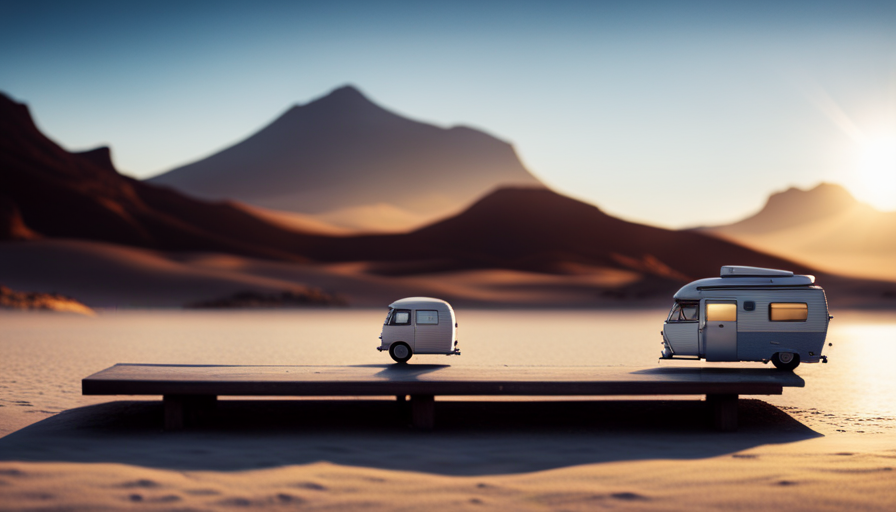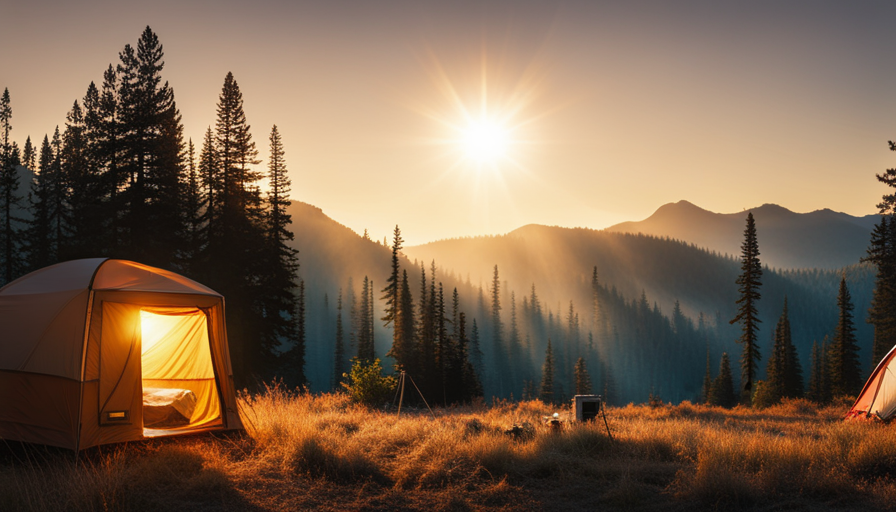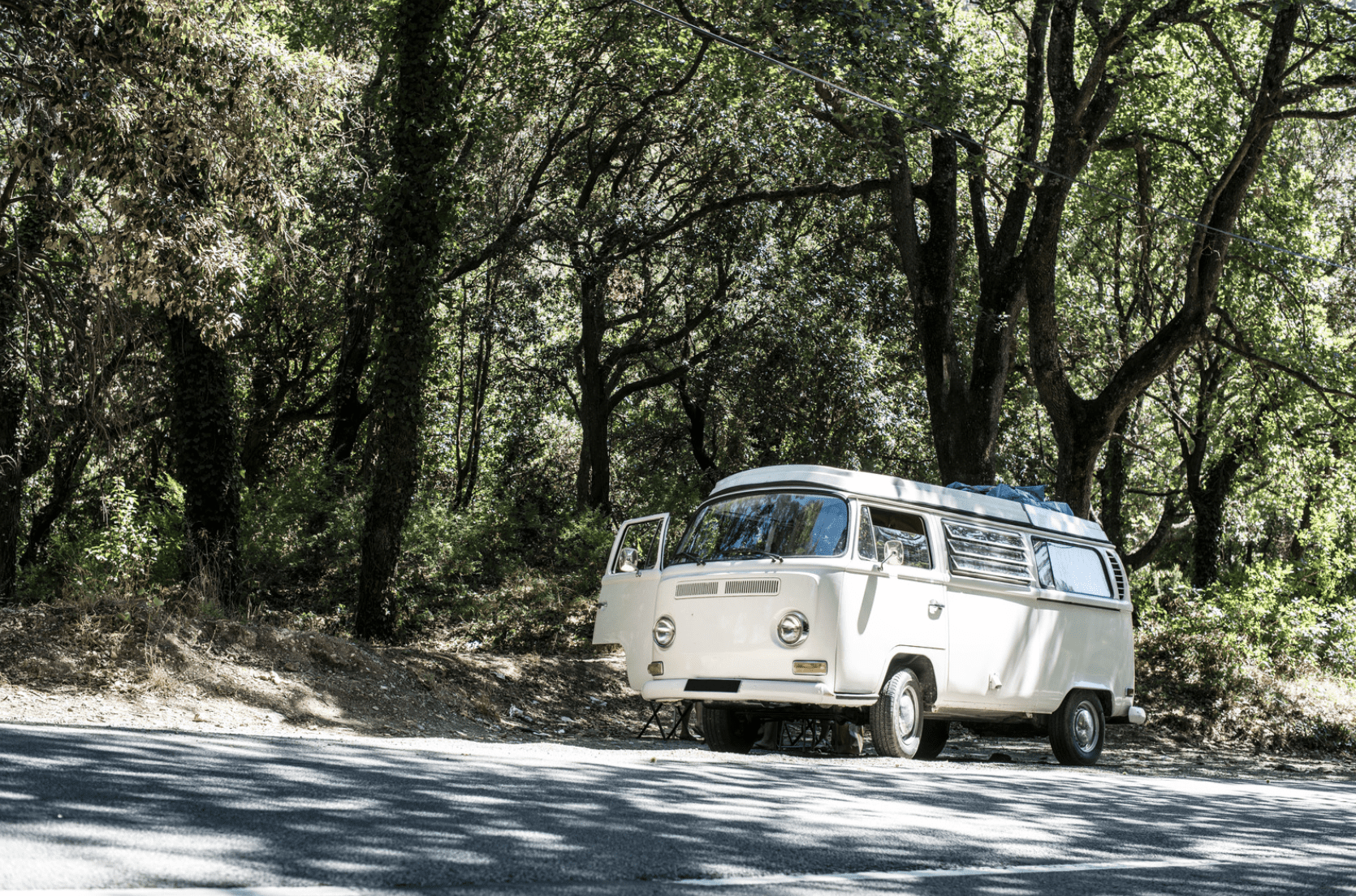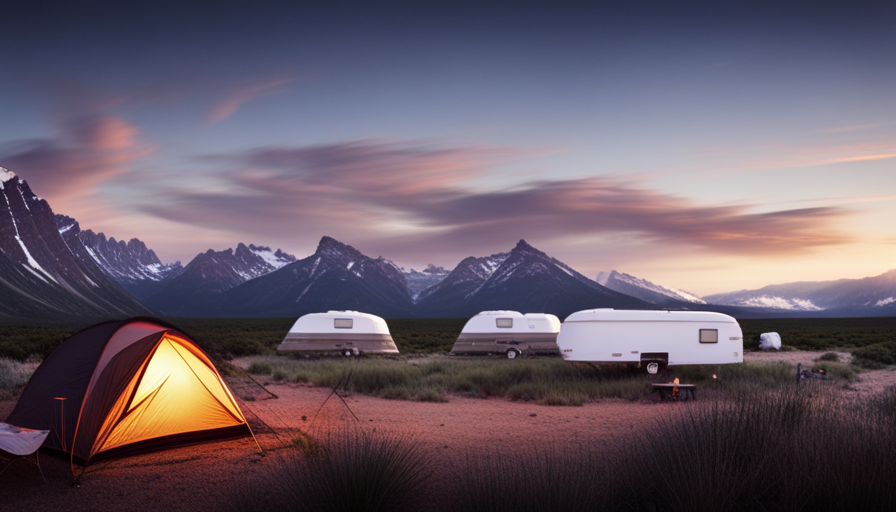Are you prepared to travel on the open road and start an unforgettable journey in the great outdoors? Before you pack your bags and hook up your camper, it’s essential to grasp the significance of GVWR.
Now, you may be wondering, what does GVWR mean on a camper? Well, let me tell you, it’s an absolute game-changer!
GVWR stands for Gross Vehicle Weight Rating, and it’s a vital specification that determines the maximum weight a vehicle or camper can safely handle. Trust me when I say, understanding GVWR is the key to ensuring a safe and enjoyable towing experience.
From calculating GVWR for different types of campers to the impact it has on performance and handling, we’ll cover it all. Plus, we’ll dive into the factors that contribute to GVWR, the consequences of overloading, and how to determine if your vehicle is up to the task.
So, buckle up and get ready to learn everything you need to know about GVWR and camper safety. Let’s hit the road with confidence and peace of mind!
Key Takeaways
- GVWR stands for Gross Vehicle Weight Rating and is crucial for safe towing.
- Exceeding the GVWR can lead to poor handling, increased braking distances, and potential accidents.
- Proper weight distribution and staying within the GVWR limits are important for stability, handling, and camper safety.
- Exceeding the GVWR can result in reduced maneuverability, damage to the camper, legal consequences, and fines.
Definition and Explanation of GVWR
If you’re planning to buy a camper, it’s crucial to understand what GVWR means. GVWR stands for Gross Vehicle Weight Rating, and it refers to the maximum weight that a vehicle can safely carry. This includes its own weight, the weight of its passengers, cargo, and any towing capacity. The GVWR is determined by the manufacturer and is often displayed on a sticker inside the driver’s side door frame.
The GVWR is calculated using specific methods that take into account various factors such as the vehicle’s suspension, brakes, frame strength, and tires. These calculations ensure that the vehicle can safely handle the weight it is designed to carry. It’s important to note that different vehicles have different GVWR limits due to variations in their design and construction.
Understanding the GVWR is crucial for safe towing. Exceeding the GVWR can put excessive strain on the vehicle’s components, leading to poor handling, increased braking distances, and even potential accidents. It’s essential to know the GVWR of your vehicle and the weight of your camper to ensure that you are within the safe limits. By understanding the GVWR, you can make informed decisions when it comes to choosing a camper and ensure a safe and enjoyable towing experience.
Importance of Understanding GVWR for Safe Towing
Understanding the importance of GVWR for safe towing is crucial, as exceeding the weight limit can lead to a 45% increase in the risk of accidents. To emphasize this point, consider the following:
-
Safety: Exceeding the GVWR of a camper can significantly impact its towing capacity, making it harder to control and maneuver on the road. This can increase the likelihood of accidents, putting not only the driver at risk but also other road users.
-
Braking Distance: Overloading a camper beyond its GVWR can affect the braking distance, potentially causing accidents due to longer stopping times. This is especially dangerous in emergency situations when quick and efficient braking is essential.
-
Structural Integrity: Proper camper loading for GVWR compliance ensures that the camper’s frame and components can withstand the weight and stress of towing. Overloading can lead to structural damage, compromising the camper’s integrity and safety.
-
Insurance Coverage: Exceeding the GVWR may void the insurance coverage for accidents, leaving you financially responsible for any damages or injuries that occur.
Understanding the impact of exceeding GVWR on towing capacity and the importance of proper camper loading for compliance is crucial for safe towing. It ensures the safety of everyone on the road and protects your investment.
In the next section, we will discuss the calculation of GVWR for different types of campers.
Calculation of GVWR for Different Types of Campers
Make sure you know how to calculate the GVWR for your specific type of camper, so you can protect your loved ones and enjoy worry-free adventures on the road.
Calculating the maximum payload capacity is crucial in ensuring that you don’t overload your camper, which can lead to dangerous situations.
To determine the appropriate towing capacity, you need to consider several factors such as the weight of the camper, including all the gear and supplies you plan to bring, as well as the weight of any passengers and additional equipment.
Start by finding the dry weight of your camper, which is the weight without any additional items. Then, add the weight of all the gear, supplies, and passengers you plan to bring.
Make sure to also account for the weight of any additional equipment, such as bikes or kayaks, that you may be carrying.
Once you have the total weight, check your camper’s specifications or consult the manufacturer to find the maximum GVWR allowed for your specific model.
Understanding how to calculate the GVWR for your camper will ensure that you stay within safe limits and prevent any potential damage or accidents.
It’s essential to remember that exceeding the GVWR can negatively impact your camper’s performance and handling, leading to increased braking distances, decreased maneuverability, and potential damage to the suspension and tires.
Knowing your camper’s GVWR will help you make informed decisions and have a safe and enjoyable camping experience.
Impact of GVWR on Camper’s Performance and Handling
Exceeding the maximum weight limit of your camper can significantly affect its performance and handling, potentially compromising your safety and overall camping experience. It is important to understand the impact of overweight on a camper’s performance to ensure a smooth and enjoyable trip.
When a camper is overloaded and exceeds its Gross Vehicle Weight Rating (GVWR), several negative effects can occur. The increased weight puts additional strain on the tires, suspension, and braking system, leading to decreased maneuverability and longer stopping distances. The camper may become unstable, making it more prone to swaying or fishtailing, especially at higher speeds. This can be particularly dangerous when driving on winding or uneven roads.
Proper weight distribution is crucial for maintaining the stability and handling of a camper. The weight should be evenly distributed between the front and rear axles, as well as side to side. Uneven weight distribution can cause the camper to lean to one side, affecting its balance and making it more difficult to control.
Exceeding the GVWR of a camper can have a significant impact on its performance and handling. It is essential to adhere to the weight limits specified by the manufacturer and ensure proper weight distribution. By doing so, you can enjoy a safer and more comfortable camping experience.
Moving on to the next section, let’s explore the factors that contribute to GVWR.
Factors That Contribute to GVWR
One must consider the various factors that contribute to the GVWR of a camper. Understanding these factors is essential for ensuring the safe and efficient operation of the vehicle. Here are four key factors that affect the GVWR and weight distribution considerations:
-
Chassis Strength: The strength and durability of the camper’s chassis play a crucial role in determining the GVWR. A robust chassis can handle higher loads without compromising safety.
-
Suspension System: The suspension system, including the springs, shocks, and axles, affects the camper’s weight distribution. Properly calibrated suspension components help distribute the weight evenly, ensuring better stability on the road.
-
Braking System: The braking system is designed to handle the weight of the camper. It should be capable of stopping the vehicle safely, even under heavy loads.
-
Tires and Wheels: The size, load rating, and inflation pressure of the tires and wheels are important factors in determining the GVWR. These components should be able to support the weight of the camper without exceeding their limits.
Considering these factors ensures that the camper operates within its GVWR limits, promoting safety and minimizing the risk of accidents.
Now let’s explore some safety tips for operating a camper within these limits.
Safety Tips for Operating a Camper within GVWR Limits
To ensure the safety of your camping experience, it’s crucial to follow these essential tips for operating your camper within the limits of its GVWR.
First and foremost, it’s important to understand the towing capacity limits of your vehicle. Exceeding these limits can put excessive strain on your engine, brakes, and suspension, compromising the safety of your camper. Always refer to your vehicle’s owner manual for this information.
In addition, regular maintenance is vital for camper safety. Create a maintenance checklist that includes inspecting tires for proper inflation and tread depth, checking and adjusting trailer brakes, ensuring all lights and signals are functioning correctly, and inspecting the hitch and safety chains for any signs of wear or damage.
Furthermore, distribute the weight inside your camper evenly to prevent overloading certain areas. This will help maintain proper balance and stability while driving. Be mindful of the weight of your belongings and avoid carrying excessive items that may push your camper over its GVWR.
By following these safety tips and adhering to your camper’s GVWR limits, you can ensure a smooth and secure camping experience. Overloading a camper’s GVWR can lead to serious consequences, which we’ll discuss in the next section.
Consequences of Overloading a Camper’s GVWR
Now that we’ve discussed some safety tips for operating a camper within GVWR limits, let’s take a closer look at the consequences of overloading a camper’s GVWR. It’s important to remember that exceeding the GVWR can have serious implications for both your safety and the well-being of your camper.
Here are four key consequences of overloading a camper’s GVWR:
-
Increased risk of accidents: Overloading a camper puts extra strain on the tires, suspension, and brakes, making it harder to control the vehicle and increasing the likelihood of accidents.
-
Reduced maneuverability: An overloaded camper may become difficult to handle, making it harder to navigate turns, change lanes, or stop quickly in emergency situations.
-
Damage to the camper: Exceeding the GVWR can cause structural damage to the camper, such as bent frames, cracked walls, or broken axles. These damages can be costly to repair and may render the camper unusable.
-
Legal consequences: Operating a camper that exceeds its GVWR can result in legal penalties, fines, or citations, as it’s considered a violation of road safety regulations.
Understanding the consequences of overloading a camper’s GVWR highlights the importance of adhering to weight limits and following safety guidelines.
In the next section, we’ll discuss how to determine if your vehicle can safely tow a camper without compromising safety.
How to Determine if Your Vehicle Can Safely Tow a Camper
Determining if our vehicle can safely tow a camper is crucial for ensuring a smooth and secure journey. One of the key factors to consider is the towing capacity of our vehicle. Towing capacity refers to the maximum weight that our vehicle can safely tow without causing damage or compromising its performance. It is essential to know the towing capacity of our vehicle before selecting a camper to avoid overloading it.
Weight distribution is another important aspect to consider when determining if our vehicle can safely tow a camper. Proper weight distribution ensures that the load is evenly distributed, reducing the risk of swaying or instability while towing. We should ensure that the weight of the camper and its contents are properly distributed, with a higher percentage of the weight towards the front of the camper.
By considering both the towing capacity and weight distribution, we can determine if our vehicle is suitable for towing a camper safely. It’s always recommended to consult our vehicle’s owner’s manual or contact the manufacturer for specific towing guidelines and restrictions.
Understanding these factors will help us make an informed decision about whether our vehicle can safely tow a camper. In the subsequent section, we’ll explore the GVWR regulations and requirements in different countries to ensure compliance with the necessary guidelines.
GVWR Regulations and Requirements in Different Countries
Understanding the GVWR regulations and requirements in different countries can help you ensure that you’re following the necessary guidelines and keeping yourself and others safe on the road. Did you know that exceeding the GVWR limit can result in fines and even lead to accidents due to decreased control and braking ability?
The GVWR regulations vary from country to country, so it’s important to familiarize yourself with the specific requirements of the country you’re traveling in. In the United States, for example, the GVWR regulations are set by the Department of Transportation and are based on factors such as vehicle type and intended use. It’s important to note that exceeding the GVWR limit can have serious consequences, including fines and potential damage to your camper and vehicle.
In Canada, the GVWR regulations are similar to those in the United States, but there may be some variations in the specific requirements. It’s important to consult the Canadian Motor Vehicle Safety Standards for the most up-to-date information on GVWR requirements for campers.
In Europe, each country has its own regulations regarding GVWR requirements for campers. It’s important to research the specific regulations of the country you plan to visit and ensure that your camper is compliant.
Understanding the GVWR regulations and requirements in different countries is crucial for safe and legal towing. By adhering to these guidelines, you can have peace of mind knowing that you’re operating within the limits and keeping yourself and others safe on the road.
For further information on GVWR and camper safety, there are resources available online and through government agencies that provide detailed information on regulations and requirements. These resources can help you ensure that you’re towing your camper safely and legally.
Resources for Further Information on GVWR and Camper Safety
To find out more about GVWR and how to ensure the safety of your camper, check out the online resources and government agencies that can provide you with detailed information on regulations and requirements. Here are three valuable resources that can help you understand camper weight distribution and provide maintenance tips for camper safety:
-
The National Highway Traffic Safety Administration (NHTSA): This government agency provides guidelines and regulations for safe towing and camper weight distribution. They offer comprehensive information on how to properly load and distribute weight in your camper to ensure safe and stable towing. Their website also includes maintenance tips and recommendations to keep your camper in top condition.
-
The Recreation Vehicle Industry Association (RVIA): This organization is dedicated to promoting the safety and quality of recreational vehicles, including campers. They have resources available that offer guidance on camper weight distribution and maintenance. The RVIA website provides valuable information on recommended weight limits for campers and tips on how to properly load and secure your belongings.
-
Camper manufacturers’ websites: Many camper manufacturers provide detailed information on weight distribution and maintenance tips specific to their models. These websites often have helpful guides and videos that demonstrate proper loading techniques and offer maintenance suggestions to ensure the longevity and safety of your camper.
By utilizing these resources, you can gain a better understanding of camper weight distribution and maintenance practices, allowing you to enjoy your camping adventures with peace of mind.
Frequently Asked Questions
What is the average GVWR for a camper?
The average GVWR for a camper is around 6,000 to 8,000 pounds. Calculating the GVWR involves adding the weight of the camper, its contents, and any additional equipment or accessories. This ensures that the camper isn’t overloaded, maintaining safety and performance.
To calculate the GVWR, consult the manufacturer’s specifications and take into account the weight of water, propane, and other supplies. Regularly checking and maintaining the GVWR is crucial for a smooth and enjoyable camping experience.
Can you exceed the GVWR of a camper if you have a larger vehicle?
Yes, it’s possible to exceed the GVWR of a camper if you have a larger vehicle. The GVWR (Gross Vehicle Weight Rating) refers to the maximum weight that a vehicle, including its cargo and passengers, can safely handle. Exceeding the GVWR can have serious consequences, such as reduced vehicle stability, increased braking distance, and excessive wear on tires and suspension components. It’s crucial to ensure that your camper doesn’t exceed the GVWR to maintain a safe and enjoyable travel experience.
Does the GVWR include the weight of passengers and cargo in the camper?
Oh, boy, let me tell you about the joy of calculating the GVWR of a camper. It’s quite the exhilarating experience, let me assure you.
When determining the GVWR, you’ll need to consider various factors like the weight of passengers, cargo, and even your hopes and dreams.
As for cargo weight, you’ll have to take into account the weight of your camping gear, supplies, and of course, your collection of rare rocks.
It’s a delicate balance, my friend, but with some careful calculation, you’ll be on your way to camper weight mastery.
Are there different GVWR requirements for different types of campers?
Yes, there are different GVWR requirements for different types of campers. The GVWR, or Gross Vehicle Weight Rating, is a crucial factor in ensuring camper safety. It determines the maximum weight a camper can safely carry, including passengers and cargo.
Different types of campers have varying structural capacities, so their GVWR requirements differ accordingly. It’s important to adhere to these requirements to prevent overloading the camper and compromising its stability and performance on the road.
What are the penalties for exceeding the GVWR of a camper?
Exceeding the GVWR of a camper can result in penalties and potential damage. Penalties may include fines, citations, or even impoundment of the vehicle.
When a camper exceeds its GVWR, it puts excessive strain on the suspension, tires, and brakes, leading to potential damage. The camper may experience reduced stability, increased stopping distance, and uneven tire wear.
It’s crucial to always stay within the specified GVWR to ensure safe and optimal performance of the camper.
Conclusion
In conclusion, understanding the GVWR of a camper is crucial for safe towing. Overloading a camper can have serious consequences on its performance and handling, putting you and others at risk.
It’s important to calculate the GVWR for different types of campers and consider factors such as weight distribution and towing capacity of your vehicle. Remember, exceeding the GVWR is like carrying a heavy load on your back while climbing a mountain – it puts unnecessary strain and can lead to a dangerous situation.
Stay informed, stay safe, and happy camping!










